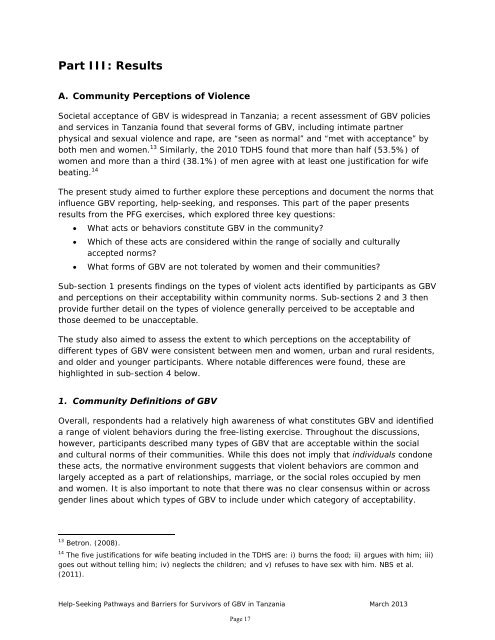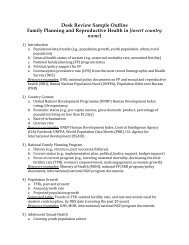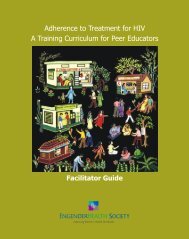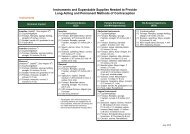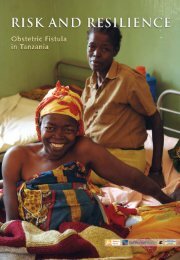Help-Seeking Pathways and Barriers for ... - EngenderHealth
Help-Seeking Pathways and Barriers for ... - EngenderHealth
Help-Seeking Pathways and Barriers for ... - EngenderHealth
Create successful ePaper yourself
Turn your PDF publications into a flip-book with our unique Google optimized e-Paper software.
Part III: Results<br />
A. Community Perceptions of Violence<br />
Societal acceptance of GBV is widespread in Tanzania; a recent assessment of GBV policies<br />
<strong>and</strong> services in Tanzania found that several <strong>for</strong>ms of GBV, including intimate partner<br />
physical <strong>and</strong> sexual violence <strong>and</strong> rape, are “seen as normal” <strong>and</strong> “met with acceptance” by<br />
both men <strong>and</strong> women. 13 Similarly, the 2010 TDHS found that more than half (53.5%) of<br />
women <strong>and</strong> more than a third (38.1%) of men agree with at least one justification <strong>for</strong> wife<br />
beating. 14<br />
The present study aimed to further explore these perceptions <strong>and</strong> document the norms that<br />
influence GBV reporting, help-seeking, <strong>and</strong> responses. This part of the paper presents<br />
results from the PFG exercises, which explored three key questions:<br />
What acts or behaviors constitute GBV in the community<br />
<br />
<br />
Which of these acts are considered within the range of socially <strong>and</strong> culturally<br />
accepted norms<br />
What <strong>for</strong>ms of GBV are not tolerated by women <strong>and</strong> their communities<br />
Sub-section 1 presents findings on the types of violent acts identified by participants as GBV<br />
<strong>and</strong> perceptions on their acceptability within community norms. Sub-sections 2 <strong>and</strong> 3 then<br />
provide further detail on the types of violence generally perceived to be acceptable <strong>and</strong><br />
those deemed to be unacceptable.<br />
The study also aimed to assess the extent to which perceptions on the acceptability of<br />
different types of GBV were consistent between men <strong>and</strong> women, urban <strong>and</strong> rural residents,<br />
<strong>and</strong> older <strong>and</strong> younger participants. Where notable differences were found, these are<br />
highlighted in sub-section 4 below.<br />
1. Community Definitions of GBV<br />
Overall, respondents had a relatively high awareness of what constitutes GBV <strong>and</strong> identified<br />
a range of violent behaviors during the free-listing exercise. Throughout the discussions,<br />
however, participants described many types of GBV that are acceptable within the social<br />
<strong>and</strong> cultural norms of their communities. While this does not imply that individuals condone<br />
these acts, the normative environment suggests that violent behaviors are common <strong>and</strong><br />
largely accepted as a part of relationships, marriage, or the social roles occupied by men<br />
<strong>and</strong> women. It is also important to note that there was no clear consensus within or across<br />
gender lines about which types of GBV to include under which category of acceptability.<br />
13 Betron. (2008).<br />
14 The five justifications <strong>for</strong> wife beating included in the TDHS are: i) burns the food; ii) argues with him; iii)<br />
goes out without telling him; iv) neglects the children; <strong>and</strong> v) refuses to have sex with him. NBS et al.<br />
(2011).<br />
<strong>Help</strong>-<strong>Seeking</strong> <strong>Pathways</strong> <strong>and</strong> <strong>Barriers</strong> <strong>for</strong> Survivors of GBV in Tanzania March 2013<br />
Page 17


